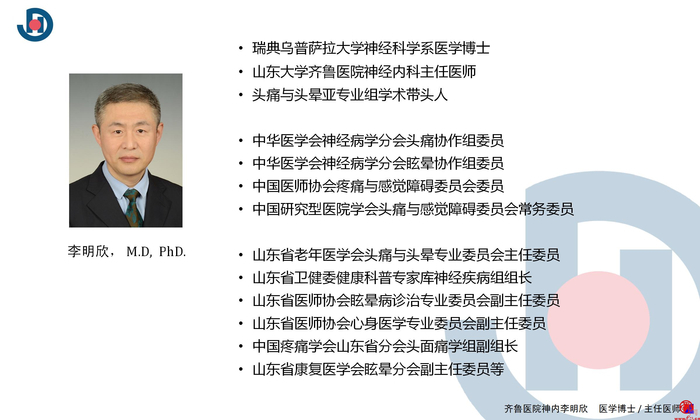With the acceleration of the pace of modern life, more and more people suffer from migraines. Migraine not only makes patients suffer pain, but also affects their daily life. In the face of migraine that has plagued us repeatedly, how should we scientifically seek medical advice and standardize treatment? On March 11, Li Mingxin, chief physician of Department of Neurology, Qilu Hospital, Shandong University, gave a detailed explanation of migraine in an interview.

Expert introduction: Li Mingxin, MD, Department of Neuroscience, Uppsala University, Sweden, Chief Physician, Department of Neurology, Qilu Hospital, Shandong University, academic leader of Headache and Dizziness Sub professional Group, member of Headache Cooperation Group of Neurology Branch of Chinese Medical Association, member of Dizziness Cooperation Group of Neurology Branch of Chinese Medical Association, Member of the Pain and Sensory Disorders Committee of the Chinese Medical Doctor Association, standing member of the Headache and Sensory Disorders Committee of the Chinese Research Hospital Association, chairman of the Headache and Dizziness Professional Committee of the Shandong Geriatrics Association, chairman of the Neurological Disease Group of the Health Science Popularization Expert Pool of the Shandong Health Commission, vice chairman of the vertigo diagnosis and treatment professional committee of the Shandong Medical Doctor Association, Vice Chairman of the Psychosomatic Medicine Professional Committee of Shandong Medical Doctor Association, Vice Chairman of the Head and Face Pain Group of Shandong Branch of China Pain Association, Vice Chairman of the Vertigo Branch of Shandong Rehabilitation Medical Association, etc.

1、 What kind of disease is migraine?
Migraine is a common nervous system disease, but also a recurring headache disease. Most patients are unilateral, but not limited to unilateral. Many patients can be bilateral, or can switch from one side to the other, and can be located in the temporal or forehead, head or back of the head. In addition, the nature of headache is usually pulsatile, like the pulsation of blood vessels. The degree of headache is generally severe, belonging to moderate and severe headache. The disease is characterized by high morbidity, high disability and high disease burden.
2、 What impact does migraine have on patients?
As a high prevalence, high disease burden or high disability disease, migraine has seriously affected the quality of life of patients and their families for a long time, and also brought serious burden to the medical system and the whole society.
In terms of high disease burden, migraine is also "linked" with 21 concomitant diseases. Migraine can seriously affect patients from the aspects of work, study, social life and even daily life, leading to their work disability, decreased quality of life, increased family burden and even accompanied by insomnia, anxiety, depression and other symptoms. In addition, it will also increase the risk of cognitive dysfunction, cardiovascular and cerebrovascular diseases.
In addition, it is highly disabling. According to the 2016 global burden of diseases (GBD) study, migraine is the second largest disability disease in the world, second only to low back pain, and the primary cause of disability for people under 50. Migraine is the second most disabling disease in the global neurological system.
At present, the incidence of migraine is relatively high in the world, with its prevalence rate reaching 12% - 18% worldwide. The young people have a high incidence, and the peak age of the disease is 35-39 years old.
3、 What are the inducements of migraine?
1. Endocrine factor
Changes in estrogen levels can cause migraine attacks. Some female migraine patients have headaches 2 to 3 days before menstruation or 2 to 3 days after menstruation, while women have fewer migraine attacks during pregnancy.
2. Eating habits
For example, intake of chocolate or cheese containing a certain ingredient, especially stale cheese; Drinking alcoholic drinks such as white wine and red wine, especially red wine; There are also some pickled foods or ham sausages that can affect the onset of headache.
3. Drug factors
Some drugs can also cause migraine attacks. For example, our most common cardiology drugs, such as nitrates for heart disease, can also cause migraine.
4. Lifestyle
The relationship between sleep and migraine is very close. The incidence of migraine in patients with sleep disorder is five times that in patients without sleep disorder. Too much sleep and too little sleep will affect the onset of migraine. In addition, pressure, anxiety, anger, nervousness, and changes in light, sound, and weather can also be used as incentives for missing a meal.
4、 What are the characteristics of migraine patients?
Unilateral and pulsatile headaches are the characteristics of migraine attacks, but sometimes migraine attacks are not unilateral and pulsatile. 40% of patients have bilateral headaches, especially children and adolescents. 80% of migraines are bilateral. 50% of the patients have a headache that is non pulsatile. At this time, attention should be paid to other characteristics of migraine, such as the headache attack is generally severe, which is characterized by moderate and severe pain. When a headache attack occurs, patients are often unwilling to do daily activities or daily activities are significantly affected because of headache. Therefore, patients often choose to lie in bed when they have attacks, which is the main clinical feature. The onset of the disease is accompanied by some nausea, vomiting and other related symptoms. In addition, the patient is particularly sensitive to light and sound, which is called photophobia. Some patients may also be particularly sensitive to some smells, which we call fear of smell. In children and adolescents with migraine, especially children and infants, a pale face will appear.
5、 How to determine whether you have migraine?
The diagnosis of migraine generally depends on a detailed medical history, which can be used to diagnose migraine according to whether it meets the clinical characteristics, such as unilateral and pulsatile headache. However, some patients are bilateral, or their pain is not a pulsatile headache, which depends on other characteristics.

Migraine is generally moderate to severe headache. When the attack occurs, the patient will have symptoms such as aggravated headache due to daily activities, or inability to carry out daily activities due to headache, and often lying in bed. Generally speaking, two of the four are considered to be a migraine like headache, but there should also be a diagnosis of related symptoms. For example, the first one is nausea with or without vomiting, and the second one is photophobia and photophobia, photophobia and photophobia.
In addition, clinicians have a simple screening standard, and patients can also serve as their own screening standard. Let's ask three simple questions:
1. In the past three months, was there a day when work, life and study were significantly affected due to headache?
2. Do you have nausea or stomach discomfort when you have a headache?
3. When you have a headache, are you afraid of light?
If the answer to all three questions is yes, the likelihood of migraine is 98%. If the two are, the probability is 93%. If there is only one or none, and if there is headache, it is still recommended that the patient go to the hospital to see the doctor in case of delay in the condition, and let the doctor make a correct diagnosis and standardized treatment.
6、 How to treat migraine patients scientifically in clinic?
In the face of patients, we should first make correct diagnosis and standardize management. Standardized management is not only drug treatment, but also health education for patients. It is necessary to tell patients what migraine is and what harm it does. Migraine is a disabling disease. Help patients find out the inducement, how to record the headache diary, and how to avoid the inducement.
In terms of drug treatment, it is also divided into two parts. One part is the treatment in the acute stage, aiming at relieving headache. The second part is preventive treatment.
In terms of treatment in the acute phase, the headache of patients should certainly be alleviated. At present, there are some traditional drug treatments, such as some painkillers such as ibuprofen. In addition, it is necessary to consider whether to give preventive treatment according to the severity of the patient, the frequency of the disease and the duration of each treatment.
There are many traditional preventive drugs. For a long time, some clinical effects of acute treatment and traditional preventive treatment are not ideal. In recent years, the treatment of migraine has entered a period of rapid development. With the continuous emergence of a new generation of CGRP receptor (or ligand) antagonists and their gradual introduction into China, this innovative drug can effectively block the key pathways related to migraine onset, and quickly and continuously relieve headache and related symptoms. It provides a new era of specific treatment for migraine.
According to Professor Li Mingxin's detailed interpretation, the correct diagnosis methods and prevention and treatment methods have been popularized for the majority of migraine patients, so as to establish scientific cognition, so that more patients can take standardized diagnosis and treatment paths and return to healthy life!
Author: Jiang Zhou Edited by: Tian Yanmin Duty director: Tian Yanmin